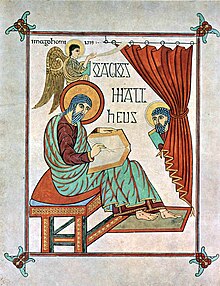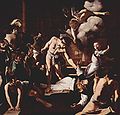Matthew (Apostle)

Matthew ( Hebrew מתתיהו Matitjahu "gift of YHWH ") is the name of a disciple of Jesus of Nazareth , who is mentioned in all apostelists as one of the twelve apostles. According to Mt 9.9 EU and Mt 10.3 EU , he is said to have been a customs officer before his appointment . Since the 2nd century the apostle Matthew has been identified with the author (unnamed in the book itself) of the first of the four gospels of the New Testament . However, this identification is largely rejected by current research. Over the centuries, Matthew was venerated and represented both as an evangelist and as an apostle in art and tradition. His sign is man .
Biblical evidence
In the enumerations of the twelve disciples specially singled out by Jesus, both in the synoptic Gospels ( Mk 3.18 EU , Lk 6.15 EU ) and in the Acts of the Apostles ( Acts 1.13 EU ) - in the seventh or eighth position - Matthew called. In the parallel passage in the Gospel of Matthew ( Mt 10.3 EU ), the addition “the tax collector” is added to his name.
Assuming the two-source theory , which is almost consensual in historical-critical exegesis , the calling history of the customs officer Matthew from Capernaum Mt 9.9–13 EU is an adaptation of the narrative of the calling of the customs officer Levi in ( Mk 2.13–17 EU ). Why is the name of Matthew, known from the apostellists, used in Mt 9: 9 instead of this name? Since the early Church, Jerome's idea has met with great approval: Out of solidarity with the apostle and ex-tax collector Matthew, the other evangelists had used the tribe name Levi instead of Matthew , "while the humble Matthew himself did not know such inhibitions and stood by his past." On the other hand, some recent interpreters understood Levi and Matthew as two different people. The evangelist would have replaced Levi with Matthew because Matthew was particularly important for the readership of the Gospel of Matthew, because he B. was as "the ancestor and chief apostle of the church area from which our gospel originates," ie Matthew as apostle of Syria. This declaration, represented by Rudolf Pesch , for example, has to struggle with the difficulty that the Gospel has no information about its Chief Apostle and inevitably ascribes a story to him that is actually about Levi. Ulrich Luz therefore says: “It is unlikely that the mt congregation revered the apostle Matthew as ... guarantor of tradition. That the apostle Matthew wrote the Gospel is, so to speak, impossible if he used Mk 2,14 EU as a source. ”Luz suspects that the apostle Matthew was still known to have been a tax collector, and therefore the name change from the otherwise unknown Levi made to Matthew. The author made a similar change to his Mark template in Mt 27.56 EU by replacing an unknown Salome with the mother of the apostles James and John. Matthias Konradt sees it similarly : the author of the Gospel had a special interest in the circle of twelve and therefore made additional references to these twelve people. The fact that he chose Matthew could be because people still knew, as 10: 3 shows, that Matthew was a tax collector.
Identification with the author of the Gospel of Matthew
In contrast to the literature on letters, the Gospel of Matthew does not mention the author by name. As early as the 2nd century, copies of the Gospel had the title "Gospel according to Matthew". The Bishop Papias of Hierapolis reported in the first half of the 2nd century in his Five Books of the Presentation of the Lord's Words according to a quotation in the Church History of Eusebius of Caesarea (3, 39, 16) that Matthew had put together a collection of Hebrew-language logia , which were then translated "everyone as best he could". Whether this note should refer to the Gospel of Matthew is controversial in today's research. In the also only fragmentary written Adversus haereses by the church father Irenaeus of Lyon (around 180), however, a clear identification of the evangelist with the apostle is made: “Matthew wrote his Gospel writing with the Hebrews in the Hebrew language, as Peter and Paul in Rome did Proclaimed the gospel and founded the church. ”Because his statements clearly show the tendency to endow the gospels used by the major church with apostolic authority in the disputes about the definition of the New Testament canon , their historical source value is mostly doubted today. However, his authority ensured that in the following centuries the authorship of the first (and therefore ranked above the others) Gospel by the apostle Matthew was considered to be secured.
Since the 19th century the authorship of the Gospel of Matthew has been increasingly doubted by an eyewitness and has been excluded by most scientifically working exegetes of today.
Legends
Since the apostle and the evangelist were taken to be the same person, there are no legends that refer to only one of the two, but only those that treat both of them in personal union.
Accordingly, he is said to have left Palestine around the year 42 to work as a missionary in Ethiopia , Mesopotamia or Persia. The place and time of death are unknown. Some texts speak of a natural death, while others speak of beheading, stabbing at the altar or burning in Syria or Arabia, which is why he is venerated as a martyr in the Latin and Greek churches .
Before 1084 his bones allegedly reached Paestum in an unknown manner , from where they were transferred to Salerno in the same year . Since then, Matthew has been venerated as patron of the city and diocese.
The pseudo-Matthew Gospel was also long regarded as the work of the Apostle Matthew.
Iconography / heraldry
In the fine arts, the depiction of the evangelist and apostle has remained fairly constant since the early book illuminations from the 8th century. He is depicted as an older man with gray, wavy hair and a gray or white beard. However, depictions from the beginnings of Byzantine art and some depictions in the Byzantine tradition deviate from this image , until the appearance of an older, bearded man also solidified there towards the end of the 12th century. In medieval art he is dressed in a long-sleeved tunic - like robe and a toga .
If the martyrdom of the Apostle shown, so he wears in exceptional cases, a chasuble as Albe , chasuble or dalmatic , each after the fashion of the time.
Theodoric of Prague , Evangelist Matthew, 1360/64
Rembrandt Inspiration of the Evangelist, 1661
Caravaggio , Martyrdom of St. Matthew . San Luigi dei Francesi , Rome. 1599/1600
Marble bust of the evangelists of Gustav Kaupert in the Basilica of Constantine in Trier, 1880
Coat of arms of Marne (Holstein)
As an evangelist he is represented with the usual attributes , that is, as a writer at a desk, with a pen, with a book or with a scroll. His evangelist symbol derived from the tetramorph , the human being or the son of man, is represented in figurative representations of the fine arts as a human figure, both without wings and winged, that is, in the appearance of an angel . If the divine inspiration of the evangelist is represented, in Matthew the person of the inspiring person and the attribute of the "angel" coincide, as for example in the picture by Rembrandt from 1661.
Attributes in depictions of Matthew as an apostle are halberd or sword as well as the utensils of a tax collector, such as a purse or counting board .
Patronage
Matthew is the patron saint of accountants, money changers, financiers and bankers and tax collectors. He is called in cases of alcoholism.
Matthew is the patron saint of Salerno and the diocese of Salerno .
Remembrance day
The Protestant church celebrates on September 21 the "Day of the Apostle and Evangelist Matthew," even in the Catholic Church the Feast of the Apostle Matthew is celebrated on 21 September, in the Orthodox Churches on November 16 .
regional customs
A number of customs, weather rules, and sayings are associated with Matthew . If someone is bankrupt, then in popular parlance Matthai is the last with him .
September 21, St. Matthew's Day, is the beginning of winter in the farmers' calendar and is an oracle day for the weather forecast:
- As Matthew does, it's four weeks .
- If Matthew enters stormily, it will be winter until Easter .
- When Matthew cries instead of laughing - he often makes vinegar out of wine .
- The winter sowing turns out well if you sow it up to Matthew .
In the Netherlands and Belgium, St. Matthew's Day is sometimes called "Winter's Day".
literature
- Gregor Martin Lechner : Matthew the Apostle and Evangelist. In: Lexicon of Christian Iconography. Volume 7. Rome, Freiburg, Basel, Vienna 1994, ISBN 3-451-22568-9 , Sp. 588-601.
- Christof Dahm : Matthäus (Greek Maththaíos). In: Biographisch-Bibliographisches Kirchenlexikon (BBKL). Volume 5, Bautz, Herzberg 1993, ISBN 3-88309-043-3 , Sp. 1030-1032.
Web links
- Literature by and about Matthäus in the catalog of the German National Library
- Matthäus (Joachim Schäfer) in the Ecumenical Lexicon of Saints , accessed on April 6, 2020
Individual evidence
- ↑ Ulrich Luz : The Gospel according to Matthew (= EKK I / 2 ). 3rd ed. Zurich et al. 1999, p. 42 note 12.
- ↑ Ulrich Luz: EKK I / 2 , 3rd ed. Zurich et al. 1999, p. 42. Cf. Rudolf Pesch: Levi-Matthäus (Mc 2,14 / Mt 9,9; 10,3). A contribution to solving an old problem . In: Journal for New Testament Science 59 (1968), pp. 40–56.
- ↑ Ulrich Luz: EKK I / 2 , 3rd edition Zurich et al. 1999, p. 43.
- ^ Matthias Konradt : The Gospel according to Matthew (= The New Testament German . Revised, Vol. 1). Vandenhoeck & Ruprecht, Göttingen 2015, p. 148 f.
- ↑ Wolfgang Wiefel : The Gospel according to Matthew (= Theological Hand Commentary on the New Testament , Volume 1). Evangelische Verlagsanstalt, Leipzig 1998, p. 12.
- ↑ Quoted from the translation by Prof. Dr. E. Klebba in the library of the church fathers ; see [1] .
- ↑ a b c d Christof Dahm: Matthäus (Greek Maththaíos) . In: Biographisch-Bibliographisches Kirchenlexikon (BBKL). Volume 5 , Bautz, Herzberg 1993, ISBN 3-88309-043-3 , Sp. 1030-1032, here 1031.
| personal data | |
|---|---|
| SURNAME | Matthew |
| ALTERNATIVE NAMES | Maththaíos; Matitjahu |
| BRIEF DESCRIPTION | Author of the Gospel of Matthew, Apostle |
| DATE OF BIRTH | 1st century |
| DATE OF DEATH | 1st century |







